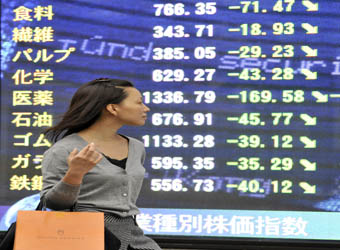Asian shares found a sliver of support on Wednesday following some punishing falls, but the reprieve could prove vanishingly short should minutes of the Federal Reserve’s July policy meeting add to suspicions it will soon pare back on stimulus.
Regional currencies were also calmer as India’s rupee managed to avoid hitting another record low, though both the Indonesian rupiah and Thai baht extended their declines.
Reports that Japan’s government would raise the severity of the latest leak at Fukushima to a level 3 event, or a serious radiation incident, sent shivers through stocks there.
But a late bounce saw the Nikkei .N225 recoup all its losses to end 0.2 percent higher. It was perhaps comforted by a declaration from Bank of Japan Governor Haruhiko Kuroda that he would not hesitate to expand the bank’s massive asset buying campaign if the economic outlook darkened.
Early indications were that European shares would start fractionally firmer. Eurostoxx 50 futures were up 0.1 percent and CAC 40 futures 0.2 percent.
Others were not so fortunate. MSCI’s index of Asia-Pacific shares outside Japan .MIAPJ0000PUS eased 0.3 percent having hit a five-week trough at one stage. Korean shares shed 1 percent .KS11 while Shanghai lost 0.3 percent .SSEC.
Emerging markets from India to Brazil have been hard-hit by the prospect of Fed tapering, which has raised U.S. borrowing costs and throttled the supply of cheap dollars formerly used to support domestic demand and fund current account deficits.
While benchmark 10-year Treasury yields edged back to 2.82 percent on Wednesday, analysts are worried the Fed minutes could jolt them higher again. A break past a major chart level at 2.90 percent would be especially bearish.
“The minutes should continue to reinforce this theme of tapering at the September meeting as long as the labor market holds up,” said Michelle Girard, chief U.S. economist at RBS.
“Along with that theme, they should also repeat another tune dear to FOMC hearts, ‘tapering is not tightening.'”
Markets, however, have listened more to the former than the latter. Indeed, there is a chance the Fed will try to reassure markets that an actual tightening in policy is still far distant, perhaps by lowering the level at which unemployment would warrant consideration of a rate rise.
Unfortunately the Fed itself is divided on all this and the minutes of its last meeting are likely to show many competing voices, perhaps leaving the market as confused as ever.
HEADING NORTH FOR THE SUMMER
Still, investors are convinced that the Fed will have to start tapering at some point and that has made it much harder for emerging market countries to attract foreign funds.
“Weakness in several key high-yielding emerging markets is overflowing to the rest,” noted analysts at Barclays. “Higher volatility will benefit countries with better balance sheets and low currency vulnerability.”
As a result they recommend a North-South rotation strategy — going long in Korea, China and Singapore, and underweight in Malaysia, Thailand and Indonesia.
The Indian rupee cratered to a record low of 64.13 per dollar on Tuesday, before steadying at 63.3 on Wednesday. Indonesia’s rupiah was at its lowest since 2009.
Late on Tuesday, India’s central bank took steps to support the beaten-down bond market, a move that did work to bring yields and market interest rates down sharply.
Among the major currencies, safe-haven flows were tending to favor the yen and Swiss franc over the U.S. dollar.
Traders also reported much talk that European investors were repatriating funds from emerging markets, which was one reason the euro spiked higher across the board. <USD/>
The common currency was up at $1.3418, having touched a six-month high of $1.3452 in New York. The dollar also slipped took a sharp spill on the Swiss franc to 0.9175 but regained some ground on the yen to 97.55.
Commodities markets were generally softer as the Fed loomed large. Copper futures dipped 0.4 percent to $7,292.75 a tonne (1.1023 ton), while spot gold inched down to $1,366.80, and away from a two-month high set on Monday. <GOL/>
Brent crude prices eased 53 cents to $109.62 a barrel, while U.S. oil for October delivery lost 47 cents to $104.64.
Source : Reuters


